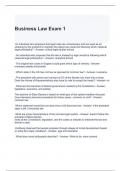Other
Biology SNAB a-level practical write up - Ecology (10)
- Module
- Practical write up
- Institution
- PEARSON (PEARSON)
Alevel biology practical write up is a report of a laboratory experiment conducted by students. It is required as part of the assessment for the subject. The a-level biology practical write up document is a professional report and should be organised in a clear and logical manner. It should inc...
[Show more]












